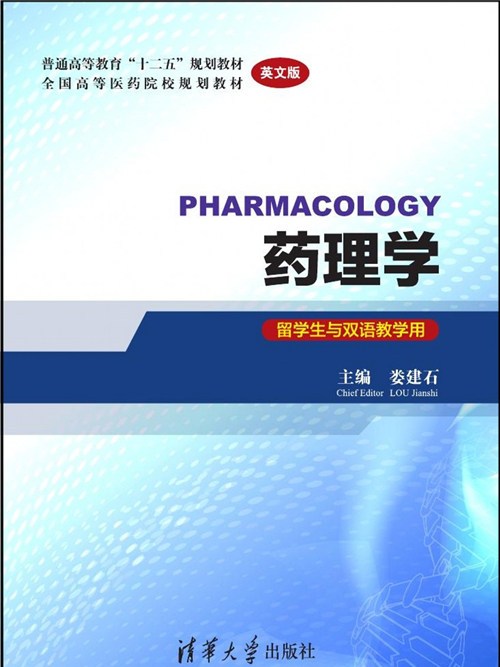內容簡介
本書系統地介紹了藥理學的基本知識,包括常用藥物的作用和原理、臨床套用、不良反應以及藥物相互作用等。內容簡明易懂,適合
臨床醫學專業學生初步學習藥理學的入門教材,也可作為其他醫學相關專業學生學習藥理學的教材,如護理學、口腔醫學、麻醉學、中西醫結合醫學、醫學檢驗、醫學影像、公共衛生和藥學專業等。本書也可供醫藥衛生專業工作人員學習和套用藥理學的參考教材。
圖書目錄
Chapter 1 Introduction…………………………………………………………………………………1
Ⅰ. Development of Pharmacology………………………………………………………………1
Ⅱ. New Drug Research……………………………………………………………………………2
Chapter 2 Pharmacodynamics…………………………………………………………………………3
Ⅰ. General Classification of Drug Effects………………………………………………………3
Ⅱ. Dose-Effect Relationship………………………………………………………………………4
Ⅲ. Receptor Theory and Drug Receptor Interaction……………………………………………6
Ⅳ. Receptor Families and Their Transducer and Effector Molecules…………………………9
Ⅴ. Relationship Between Regulatory Mechanisms of Receptors and
the Pharmacological Action…………………………………………………………………11
Ⅵ. Mechanism of Action…………………………………………………………………………12
Chapter 3 Pharmacokinetics……………………………………………………………………………13
Ⅰ. Drug Transport across Membranes…………………………………………………………13
Ⅱ. The Dynamics of Drug Absorption, Distribution, and Elimination………………………14
Ⅲ. General Principles of Pharmacokinetics……………………………………………………19
Chapter 4 Pharmacogenetics…………………………………………………………………………24
Ⅰ. The Objectives of Research in Pharmacogenetics……………………………………………24
Ⅱ. The Effect of Genetic Factors on Drug Reactions……………………………………………25
Ⅲ. The Racial Difference of Drug Reaction and Metabolism…………………………………29
Chapter 5 Autonomic Pharmacology…………………………………………………………………31
Ⅰ. Anatomy and Neurotransmitter Chemistry of the Autonomic Nervous System………31
Ⅱ. Biosynthesis and Metabolism of Transmitters………………………………………………32
Ⅲ. Locations of Autonomic Receptors……………………………………………………………35
Ⅳ. Presynaptic Regulation of Transmitter Release……………………………………………36
Ⅴ. Functional Organization of Autonomic Activity……………………………………………38
Ⅵ. Coupling Mechanism of Receptor-effect……………………………………………………39
Ⅶ. Mode of Action of Autonomic Nervous System Drugs……………………………………40
Ⅷ. Classification of Autonomic Nervous System Drugs………………………………………41
Chapter 6 Cholinoceptor-Activating and Cholinesterase-Inhibiting Drugs………………………42
Ⅰ. Direct-acting Cholinoceptor Stimulants……………………………………………………42
Ⅱ. Cholinesterase Inhibitors………………………………………………………………………44
Chapter 7 Organophosphates Anticholinesterase Intoxication and Cholinesterase Reactivators……47
Ⅰ. Organophosphates Anticholinesterase Intoxication………………………………………47
Ⅱ. Cholinesterase Reactivator……………………………………………………………………48
Chapter 8 M Cholinoceptor Antagonists………………………………………………………………50
Ⅰ. Natural M Cholinoceptor Blocking Drugs…………………………………………………50
Ⅱ. Synthetic Spasmolytic Drugs…………………………………………………………………53
Chapter 9 N Cholinoceptor Antagonists………………………………………………………………54
Ⅰ. N1 Cholinoceptor Blocking Drugs……………………………………………………………54
Ⅱ. N2 Cholinoceptor Blocking Drugs……………………………………………………………55
Chapter 10 Adrenoceptor-Activating Drugs…………………………………………………………58
Ⅰ. Chemical Structure……………………………………………………………………………58
Ⅱ. Classification……………………………………………………………………………………59
Ⅲ. Mixed α and β Receptor Agonists……………………………………………………………60
Ⅳ. α Receptor Agonists……………………………………………………………………………63
Ⅴ. β Receptor Agonists ……………………………………………………………………………64
Ⅵ. Dopaminergic Receptor Agonists……………………………………………………………66
Chapter 11 Adrenoceptor Blocking Drugs……………………………………………………………69
Ⅰ. α Receptor Antagonists…………………………………………………………………………69
Ⅱ. β Receptor Antagonists ………………………………………………………………………73
Ⅲ. α, β Receptor Antagonists……………………………………………………………………76
Chapter 12 Sedative-Hypnotics Drugs…………………………………………………………………78
Ⅰ. Introduction……………………………………………………………………………………78
Ⅱ. Benzodiazepines………………………………………………………………………………79
Ⅲ. Barbiturates……………………………………………………………………………………83
Ⅳ. Other Sedative-Hypnotics……………………………………………………………………85
Chapter 13 Antiepileptic Drugs………………………………………………………………………88
Ⅰ. Classification of Seizure Types………………………………………………………………88
Ⅱ. Drugs Used in Seizures………………………………………………………………………89
Ⅲ. Selectivity and Withdrawal of Antiepileptic Drugs…………………………………………94
Ⅳ. Anticonvulsant Drugs…………………………………………………………………………95
Chapter 14 Psychotropic Drugs………………………………………………………………………97
Ⅰ. Antipsychotic Drugs……………………………………………………………………………97
Ⅱ. Antimanic Drugs……………………………………………………………………………103
Ⅲ. Antidepressants………………………………………………………………………………105
Chapter 15 Antiparkinsonism Drugs………………………………………………………………108
Ⅰ. Dopaminergic Drugs………………………………………………………………………108
Ⅱ. Anticholinergic Drugs………………………………………………………………………111
Ⅲ. Others…………………………………………………………………………………………112
Chapter 16 Antipyretic-Analgesic and Antiinflammatory Drugs…………………………………113
Ⅰ. Introduction…………………………………………………………………………………113
Ⅱ. Salicylates……………………………………………………………………………………115
Ⅲ. Anilines………………………………………………………………………………………117
Ⅳ. Pyrazolones…………………………………………………………………………………117
Ⅴ. Others…………………………………………………………………………………………118
Ⅵ. Analgesic Compounds………………………………………………………………………120
Ⅶ. Slow Acting Antirheumatic Drugs…………………………………………………………120
Ⅷ. Antigout Drugs………………………………………………………………………………121
Chapter 17 Narcotic Analgesics……………………………………………………………………123
Ⅰ. Introduction…………………………………………………………………………………123
Ⅱ. Opioid Receptor Agonists…………………………………………………………………125
Ⅲ. Opioid Receptor Antagonists………………………………………………………………130
Chapter 18 Central Stimulants………………………………………………………………………132
Ⅰ. Cerebral Stimulants…………………………………………………………………………132
Ⅱ. Medullary Stimulants………………………………………………………………………135
Chapter 19 Drugs Used in the Treatment of Heart Failure………………………………………136
Ⅰ. Pathophysiology of Congestive Heart Failure……………………………………………136
Ⅱ. Diuretics………………………………………………………………………………………138
Ⅲ. Aldosterone Antagonists……………………………………………………………………138
Ⅳ. Inhibitors of RAAS: ACEI and AT1 Receptor Antagonists………………………………138
Ⅴ. β Adrenergic Receptor Blocking Agents…………………………………………………139
Ⅵ. Vasodilators…………………………………………………………………………………139
Ⅶ. Cardiac Glycosides…………………………………………………………………………139
Ⅷ. β Adrenergic Receptor Stimulators………………………………………………………146
Ⅸ. Phosphodiesterase Inhibitors………………………………………………………………147
Chapter 20 Antihypertensive Drugs…………………………………………………………………148
Ⅰ. Introduction…………………………………………………………………………………148
Ⅱ. Drugs that Alter Sodium and Water Balance……………………………………………150
Ⅲ. Drugs that Alter Sympathetic Nervous System Function………………………………152
Ⅳ. Vasodilators…………………………………………………………………………………156
Ⅴ. Drugs that Interfere with the Renin-Angiotensin System………………………………160
Ⅵ. Clinical Pharmacology of Antihypertensive Drugs………………………………………162
Chapter 21 Anti-Angina Pectoris Drugs……………………………………………………………164
Ⅰ. Introduction…………………………………………………………………………………164
Ⅱ. Nitrates and Nitrites…………………………………………………………………………165
Ⅲ. Calcium Channel Blockers…………………………………………………………………167
Ⅳ. β Receptor Antagonists……………………………………………………………………167
Chapter 22 Antiarrhythmic Drugs…………………………………………………………………170
Ⅰ. Introduction…………………………………………………………………………………170
Ⅱ. Class ⅠA………………………………………………………………………………………174
Ⅲ. Class ⅠB………………………………………………………………………………………176
Ⅳ. Class ⅠC………………………………………………………………………………………178
Ⅴ. Class Ⅱ………………………………………………………………………………………178
Ⅵ. Class Ⅲ………………………………………………………………………………………179
Ⅶ. Class Ⅳ………………………………………………………………………………………180
Ⅷ. Others…………………………………………………………………………………………181
Chapter 23 Antihyperlipidemic Drugs………………………………………………………………184
Ⅰ. Atherogenesis………………………………………………………………………………184
Ⅱ. Lipoprotein Transport………………………………………………………………………185
Ⅲ. Dyslipidaemia………………………………………………………………………………186
Ⅳ. Antihyperlipidemic Drugs…………………………………………………………………186
Chapter 24 Diuretic and Dehydrant Drugs…………………………………………………………191
Ⅰ. Kidney Structure and Function……………………………………………………………191
Ⅱ. Diuretics………………………………………………………………………………………193
Ⅲ. Osmotic Diuretics (Mannitol, Sorbitol, Glucose, Urea)…………………………………198
Chapter 25 Antiasthmatic Drugs……………………………………………………………………199
Ⅰ. Bronchodilators………………………………………………………………………………199
Ⅱ. Anti-Inflammatory Drugs…………………………………………………………………203
Chapter 26 Drugs Used in Gastrointestinal Diseases………………………………………………206
Ⅰ. Drugs Used to Treat Peptic Ulcer…………………………………………………………206
Ⅱ. Antiemetic Drugs……………………………………………………………………………210
Ⅲ. Antidiarrheal Drugs…………………………………………………………………………212
Ⅳ. Laxatives………………………………………………………………………………………212
Chapter 27 Drugs Affecting Uterine Motility………………………………………………………214
Ⅰ. Drugs that Stimulate Uterine Contraction………………………………………………214
Ⅱ. Drugs that Inhibit Uterine Contraction……………………………………………………216
Chapter 28 Anticoagulants and Coagulants………………………………………………………217
Ⅰ. Introduction…………………………………………………………………………………217
Ⅱ. Anticoagulants………………………………………………………………………………219
Ⅲ. Antiplatelet Drugs……………………………………………………………………………223
Ⅳ. Fibrinolytic Drugs……………………………………………………………………………225
Ⅴ. Coagulants……………………………………………………………………………………226
Chapter 29 Histamine and Antihistamine Drugs…………………………………………………228
Ⅰ. Histamine……………………………………………………………………………………228
Ⅱ. H1 Receptor Antagonists……………………………………………………………………231
Ⅲ. H2 Receptor Antagonists……………………………………………………………………232
Chapter 30 Adrenocorticosteroids…………………………………………………………………234
Ⅰ. Introduction…………………………………………………………………………………234
Ⅱ. Glucocorticoids………………………………………………………………………………235
Ⅲ. Mineralocorticoids…………………………………………………………………………243
Chapter 31 Drugs Affecting the Thyroid Gland…………………………………………………245
Ⅰ. Thyroid Hormone (TH)……………………………………………………………………245
Ⅱ. Antithyroid Drugs……………………………………………………………………………247
Chapter 32 Antidiabetic Drugs………………………………………………………………………250
Ⅰ. Insulin…………………………………………………………………………………………250
Ⅱ. Oral Hypoglycemic Drugs…………………………………………………………………254
Ⅲ. Current Treatment Options…………………………………………………………………258
Chapter 33 Introduction to Antibacterial Drugs…………………………………………………259
Ⅰ. Specialty Terms………………………………………………………………………………259
Ⅱ. Antimicrobial Mechanisms…………………………………………………………………260
Ⅲ. Mechanism of Resistance to Antibiotics…………………………………………………261
Chapter 34 Synthetic Antimicrobial Drugs…………………………………………………………263
Ⅰ. Sulfonamides…………………………………………………………………………………263
Ⅱ. Trimethoprim…………………………………………………………………………………265
Ⅲ. Quinolones……………………………………………………………………………………268
Chapter 35 β-Lactam Antibiotics…………………………………………………………………272
Ⅰ. Penicillins……………………………………………………………………………………272
Ⅱ. Cephalosporins………………………………………………………………………………278
Ⅲ. Other β-Lactam Drugs………………………………………………………………………281
Chapter 36 Macrolides, Lincosamides and Glycopeptides………………………………………284
Ⅰ. Macrolides……………………………………………………………………………………284
Ⅱ. Lincosamides…………………………………………………………………………………288
Ⅲ. Glycopeptides………………………………………………………………………………290
Chapter 37 Broad-Spectrum Antibiotics……………………………………………………………292
Ⅰ. Tetracyclines…………………………………………………………………………………292
Ⅱ. Chloramphenicols……………………………………………………………………………296
Chapter 38 Aminoglycosides and Polypeptides……………………………………………………299
Ⅰ. Aminoglycosides……………………………………………………………………………299
Ⅱ. Polypeptides…………………………………………………………………………………305
Chapter 39 Antifungal Drugs………………………………………………………………………306
Ⅰ. Antibiotics……………………………………………………………………………………306
Ⅱ. Azole Antifungal Drugs……………………………………………………………………307
Ⅲ. Allylamine Antifungal Drugs………………………………………………………………308
Ⅳ. Pyrimidine Antifungal Drugs………………………………………………………………308
Chapter 40 Antiviral Drugs…………………………………………………………………………310
Ⅰ. Anti-Human Immunodeficiency Virus Drugs……………………………………………311
Ⅱ. Anti-Herpersvirus Drugs……………………………………………………………………318
Ⅲ. Anti-Influenza Drugs………………………………………………………………………324
Ⅳ. Anti-Hepacivirus Drugs……………………………………………………………………328
Chapter 41 Antimycobacterial Drugs………………………………………………………………332
Ⅰ. Introduction…………………………………………………………………………………332
Ⅱ. First-Line Drugs Used in Tuberculosis……………………………………………………332
Ⅲ. Alternative Second-Line Drugs in Treatment of Tuberculosis…………………………337
Ⅳ. Combination Chemotherapy of Tuberculosis……………………………………………339
Chapter 42 Antimalarial Drugs……………………………………………………………………340
Ⅰ. Plasmodium Life Cycles and Action of Antimalarial Drugs……………………………340
Ⅱ. Antimalarial Drugs Mainly Applied to Control Symptoms……………………………341
Ⅲ. Antimalarial Drugs Mainly Applied to Control Relapse and Transmission…………351
Ⅳ. Antimalarial Drugs Mainly Applied to Causal Prophylaxis……………………………352
Chapter 43 Amebicides………………………………………………………………………………355
Ⅰ. Life Cycles of Entamoeba Histolytica and Action of Amebicides…………………………355
Ⅱ. Luminal Amebicides…………………………………………………………………………356
Ⅲ. Extraintestinal Amebicides…………………………………………………………………359
Ⅳ. Luminal and Simultaneously Extraintestinal Amebicides………………………………360
Chapter 44 Anthelmintic Drugs……………………………………………………………………364
Ⅰ. Nematocides…………………………………………………………………………………364
Ⅱ. Taeniacides……………………………………………………………………………………366
Ⅲ. Anti-Trematode Drugs………………………………………………………………………366
Chapter 45 Antineoplastic Drugs……………………………………………………………………369
Ⅰ. Introduction…………………………………………………………………………………369
Ⅱ. Cytotoxic Drugs………………………………………………………………………………372
Ⅲ. Non-Cytotoxic Drugs………………………………………………………………………378
References………………………………………………………………………………………………382

